
Taunton is a city in Bristol County, Massachusetts, United States. It is the seat of Bristol County. Taunton is situated on the Taunton River which winds its way through the city on its way to Mount Hope Bay, 10 miles (16 km) to the south. At the 2020 census, the city had a population of 59,408. Shaunna O'Connell is the mayor of Taunton.

Taunton State Hospital is a psychiatric hospital located on Hodges Avenue in Taunton, Massachusetts. Established in 1854, it was originally known as the State Lunatic Hospital at Taunton. It was the second state asylum in Massachusetts. Most of the original part of the facility was built in a unique and rare neo-classical style designed by architects Boyden & Ball. It is also a Kirkbride Plan hospital and is located on a large 154-acre (62 ha) farm along the Mill River.
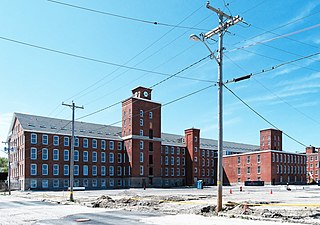
Wamsutta Mills is a former textile manufacturing company and current brand for bedding and other household products. Founded by Thomas Bennett, Jr. on the banks of the Acushnet River in New Bedford, Massachusetts in 1846 and opened in 1848, Wamsutta Mills was named after Wamsutta, the son of a Native American chief who negotiated an early alliance with the English settlers of the Plymouth Colony. It was the first of many textile mills in New Bedford, and gradually led to cotton textile manufacturing overtaking whaling as the town's principal industry by the 1870s.
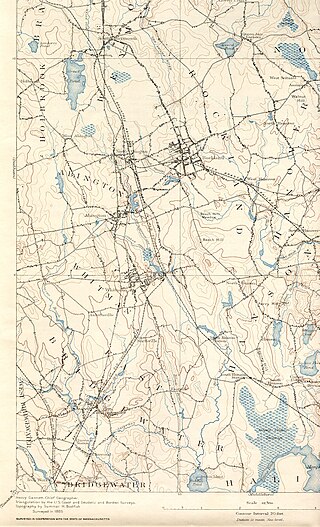
The Satucket River is 5.5-mile-long (8.9 km) river in southeastern Massachusetts within the Taunton River Watershed. It flows generally west from Robbins Pond in East Bridgewater, and into the Matfield River.
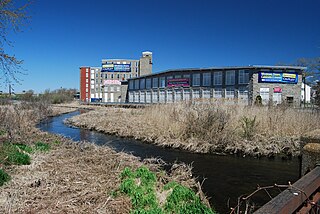
The Quequechan River is a river in Fall River, Massachusetts, that flows in a northwesterly direction from the northwest corner of the South Watuppa Pond through the heart of the city of Fall River and into the end of the Taunton River at Mount Hope Bay at Heritage State Park/Battleship Cove. The word Quequechan means "Falling River" or "Leaping/Falling Waters" in Wampanoag, hence the city's name.
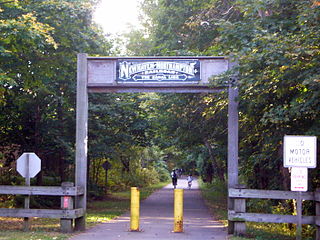
The Farmington Canal, also known as the New Haven and Northampton Canal, was a major private canal built in the early 19th century to provide water transportation from New Haven into the interior of Connecticut, Massachusetts and beyond. Its Massachusetts segment was known as the Hampshire and Hampden Canal. With the advent of railroads, it was quickly converted to a railroad in the mid-19th century and in recent years has been converted to a multi-use trail after being abandoned for years.

Pocasset Manufacturing Company was a cotton textile mill located in Fall River, Massachusetts. It was located just west of Main Street across the second falls of the Quequechan River. It was organized on August 15, 1821, with $100,000 in capital. The mill began operation in 1822, with Samuel Rodman of New Bedford as the principal owner. Oliver Chace, served as the mill's agent until 1837. Nathaniel Briggs Borden was named clerk and treasurer.
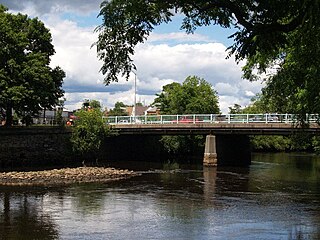
Weir Village is a village of the city of Taunton in Bristol County, Massachusetts, located about one mile south of the city center on the banks of the Taunton River, near the point where it becomes tidal. The village takes its name from fishing weirs which were placed across the Taunton River from pre-colonial times until the early 20th century, to catch herring. While much of the commercial part of the village lies on the west side of the river, along Weir Street , a dense residential area extends in an easterly direction across the river along Plain and Berkley Streets.

Colonel Richard Borden (1795–1874) was an American businessman and civic leader from Fall River, Massachusetts. He co-founded the Fall River Iron Works in 1821, and later built several early cotton mills, as well as the Fall River Line, Fall River Gas Works Company, the Fall River Railroad, banks and other businesses. The Borden family would dominate the economic and civic life of Fall River into the early 20th century.

The Taunton Green Historic District encompasses the core area of the historic 19th-century commercial downtown business district of Taunton, Massachusetts. It is centered on the town green, laid out in the 1740s, and now stands at the intersection of U.S. Route 44 and State routes 140 and 138. The district was listed on the National Register of Historic Places in 1985.

Sanford Spinning Company is an historic mill complex located on Globe Mills Avenue in Fall River, Massachusetts. It was added to the National Register of Historic Places in 1983, along with the adjacent Globe Yarn Mills #3.

The Harris Street Bridge is a historic truss bridge that spans the Taunton River off Dean Street in Taunton, Massachusetts. Built in 1887, it is the oldest surviving bridge in the city, and was built as part of the one of the city's earliest public works projects after incorporation as a city. It was added to the National Register of Historic Places in 1984. It is closed to traffic, and is in disrepair.

The Old Colony Iron Works-Nemasket Mills Complex is a historic industrial site located on Old Colony Avenue in the East Taunton section of Taunton, Massachusetts, United States, adjacent to the Taunton River at the Raynham town line. The site was first occupied by the Old Colony Iron Company, which had originally been established in the 1820s as Horatio Leonard & Company. The western part of the complex was sold to Nemasket Mills in 1889. The eastern part was acquired by the Standard Oil Cloth Company. The site was added to the National Register of Historic Places in 1984.

Globe Yarn Mills are two historic textile mills located at 460 Globe Street in Fall River, Massachusetts.

The Whittenton Mills Complex is a historic textile mill site located on Whittenton Street in Taunton, Massachusetts, on the banks of the Mill River. The site has been used for industrial purposes since 1670, when James Leonard built an iron forge on the west bank of the river. The first textile mill was built in 1805 and expanded throughout the 19th century. The complex was added to the National Register of Historic Places in 1984, and now contains various small businesses.

The Old Weir Stove Company was an historic industrial facility located on West Water Street in Weir Village, Taunton, Massachusetts. The factory consisted of a series of connected brick buildings, located between West Water Street and the west bank of the Taunton River. The factory was built in 1902 and added to the National Register of Historic Places in 1984. It was later occupied by F.B. Rogers Silver Company. In May–June 2009, the site was demolished, except for the northernmost building of the complex.
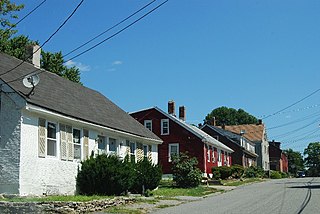
The Hopewell Mills District is a historic district on Bay Street and Albro Avenue in Taunton, Massachusetts. The site is associated with the Hopewell Mills, one of the earliest textile mills in the city, established in 1818.

Oliver Mill Park is a municipal park on Nemasket Street in Middleborough, Massachusetts. It contains the remains of a major 18th century industrial complex developed by Peter Oliver, which included several mills, a blast furnace, and forge. It was listed on the National Register of Historic Places in 2000 as the Muttock Historic and Archeological District.

The North Canal Historic District of Lawrence, Massachusetts, encompasses the historic industrial heart of the city. It is centered on the North Canal and the Great Stone Dam, which provided the waterpower for its many mill complexes. The canal was listed on the National Register of Historic Places in 1975, while the district was first listed in 1984, and then expanded slightly in 2009.

The Manomet Mills are a historic textile mill complex on the north side of New Bedford, Massachusetts. They are located between Riverside Avenue and the Acushnet River, north of Manoment Street and the Whitman Mills. The complex consists of three Classical Revival brick buildings, built between 1903 and 1907. The main building, Mill No. 1, is a 54-bay three story structure that was built in 1903. It is attached to Mill No. 2 (1907), of similar size, by a single story brick structure. The third building is the Mill No. 2 Department Room (1907), a two-story brick building that was originally connected to the other two via overhead bridges, now removed. The mill complex was the main operating site of the Manoment Mill Company, which produced cotton yarn until about 1928. The buildings were sold in that year to the Delaware Rayon Company, which went bankrupt in 1954. Mill No. 2 was then used by the Acushnet Process Company for the manufacture of golf balls, while Mill No. 1 continued to be used for rayon production, a chemically intensive and environmentally hazardous process.























